中职英语2-教案
- 格式:doc
- 大小:43.00 KB
- 文档页数:4
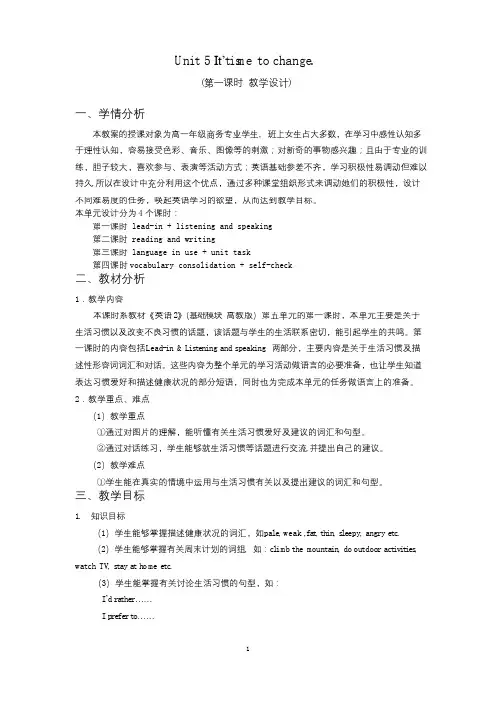
U nit 5It’t i s m e to change.(第一课时教学设计)一、学情分析本教案的授课对象为高一年级商务专业学生, 班上女生占大多数,在学习中感性认知多于理性认知,容易接受色彩、音乐、图像等的刺激;对新奇的事物感兴趣;且由于专业的训练,胆子较大,喜欢参与、表演等活动方式;英语基础参差不齐,学习积极性易调动但难以持久,所以在设计中充分利用这个优点,通过多种课堂组织形式来调动她们的积极性,设计不同难易度的任务,唤起英语学习的欲望,从而达到教学目标。
本单元设计分为4 个课时:第一课时 lead-in + listening and speaking第二课时 reading and writing第三课时 language in use + unit task第四课时vocabulary consolidation + self-check二、教材分析1.教学内容本课时系教材《英语2》(基础模块高教版)第五单元的第一课时,本单元主要是关于生活习惯以及改变不良习惯的话题,该话题与学生的生活联系密切,能引起学生的共鸣。
第一课时的内容包括Lead-in & Lis tening and speak ing 两部分,主要内容是关于生活习惯及描述性形容词词汇和对话。
这些内容为整个单元的学习活动做语言的必要准备,也让学生知道表达习惯爱好和描述健康状况的部分短语,同时也为完成本单元的任务做语言上的准备。
2.教学重点、难点(1)教学重点①通过对图片的理解,能听懂有关生活习惯爱好及建议的词汇和句型。
②通过对话练习,学生能够就生活习惯等话题进行交流,并提出自己的建议。
(2)教学难点①学生能在真实的情境中运用与生活习惯有关以及提出建议的词汇和句型。
三、教学目标1.知识目标(1)学生能够掌握描述健康状况的词汇,如pa le,weak,fa t,th in,s l e epy,angry e tc.(2)学生能够掌握有关周末计划的词组,如:c l imb the mounta in, do outdoor ac t iv i t i e s, watch TV, s tay a t ho me e tc.(3)学生能掌握有关讨论生活习惯的句型,如:I’d ra the r……I p re fe r t o……(1)学生能听懂有关培养健康习惯的建议和意见。
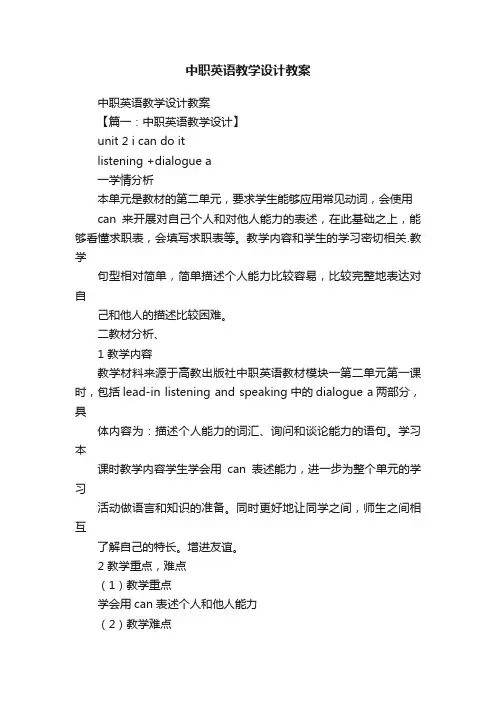
中职英语教学设计教案中职英语教学设计教案【篇一:中职英语教学设计】unit 2 i can do itlistening +dialogue a一学情分析本单元是教材的第二单元,要求学生能够应用常见动词,会使用can来开展对自己个人和对他人能力的表述,在此基础之上,能够看懂求职表,会填写求职表等。
教学内容和学生的学习密切相关.教学句型相对简单,简单描述个人能力比较容易,比较完整地表达对自己和他人的描述比较困难。
二教材分析、1 教学内容教学材料来源于高教出版社中职英语教材模块一第二单元第一课时,包括lead-in listening and speaking中的dialogue a两部分,具体内容为:描述个人能力的词汇、询问和谈论能力的语句。
学习本课时教学内容学生学会用can表述能力,进一步为整个单元的学习活动做语言和知识的准备。
同时更好地让同学之间,师生之间相互了解自己的特长。
增进友谊。
2 教学重点,难点(1)教学重点学会用can 表述个人和他人能力(2)教学难点表达个人能力的词汇,词组的记忆三教学目标1. 知识目标⑴掌握描述个人能力的词汇,speak chinese, drive cars, repair computers, teach english, read in chinese, serve customers. ⑵掌握询问和描述个人能力时所使用的句型,can you say something about yourself?can you sing english songs?well, i can teach english and i can speak a little chinese.2. 能力目标⑴听用情态动词can表述的有关个人能力的介绍(2)说会用can表达有关个人能力和他人能力的介绍3. 情感目标了解自己的能力欣赏自我的同时,看到他人的长处四学生分析each coin has two sides.the students in class are all boys. they prefer learning major skills to language points,they dislike english grammar and speaking english. many of them are weak at english . on the other hand they are active and energetic .they are interested in electronic products and internet .they are good at running programs in smart cell -phones and internet .it is easy for them to accept new ideas ,which is of great help to this period 五教学过程step 1 lead-in(1)talk about abilitiesplay ppt for the ss(2)look and complete.activity 1 on page23ask the students to describe each picture, using the sentence pattern “he/she/they can …” after that, the teacher may ask the students to listen to the tape and circle what ben can do.(设计意图:通过ppt快速展示名人的能力图片,引导学生学习can 的表述。
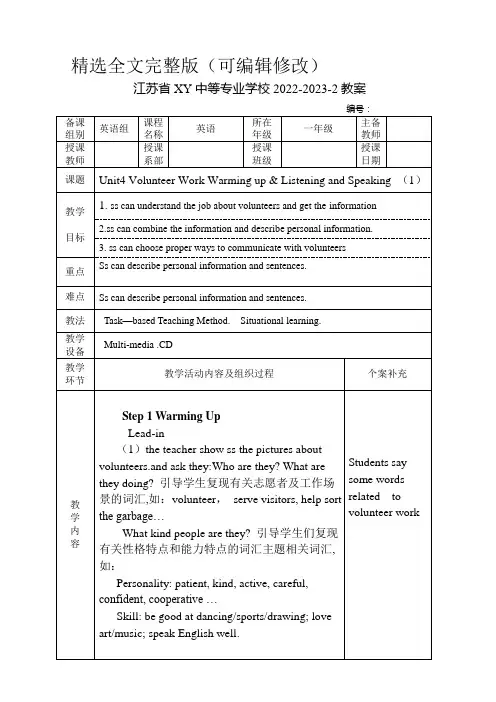
精选全文完整版(可编辑修改)
江苏省XY中等专业学校2022-2023-2教案
江苏省XY中等专业学校2022-2023-2教案
江苏省XY中等专业学校2022-2023-2教案
江苏省XY中等专业学校2022-2023-2教案
江苏省XY中等专业学校2022-2023-2教案
江苏省XY中等专业学校2022-2023-2教案
在这一学年中,不仅在业务能力上,还是在教育教学上都有了一定的提高。
金无足赤,人无完人,在教学工作中难免有缺陷,例如,课堂语言平缓,语言不够生动,理论知识不够,教学经验不足,组织教学能力还有待提高。
在今后的工作中,我将更严格要求自己,努力工作,发扬优点,改正缺点。
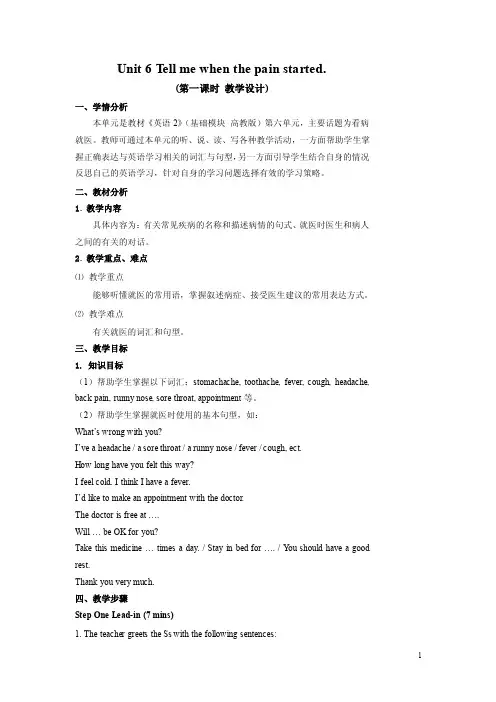
Unit 6 T ell me when the pain started.(第一课时教学设计)一、学情分析本单元是教材《英语2》(基础模块高教版)第六单元,主要话题为看病就医。
教师可通过本单元的听、说、读、写各种教学活动,一方面帮助学生掌握正确表达与英语学习相关的词汇与句型,另一方面引导学生结合自身的情况反思自己的英语学习,针对自身的学习问题选择有效的学习策略。
二、教材分析1. 教学内容具体内容为:有关常见疾病的名称和描述病情的句式、就医时医生和病人之间的有关的对话。
2. 教学重点、难点⑴教学重点能够听懂就医的常用语,掌握叙述病症、接受医生建议的常用表达方式。
⑵教学难点有关就医的词汇和句型。
三、教学目标1.知识目标(1)帮助学生掌握以下词汇:stomachache, toothache, fever, cough, headache, back pain, runny nose, sore throat, appointment等。
(2)帮助学生掌握就医时使用的基本句型,如:What’s wrong with you?I’ve a headache / a sore throat / a runny nose / fever / cough, ect.How long have you felt this way?I feel cold. I think I have a fever.I’d like to make an appointment with the doctor.The doctor is free at ….Will … be OK for you?Take this medicine … times a day. / Stay in bed for …. / Y ou should have a good rest.Thank you very much.四、教学步骤Step One Lead-in (7 mins)1. The teacher greets the Ss with the following sentences:How are you, boys and girls?I didn’t sleep well last night.I’ve had a cold because ….I’m not myself today.Explain I’m not myself today and get the Ss to say something about themselves. Step T wo Listening and speaking (30 mins)1. Before listening, ask the Ss to look at the picture and answer the question: What’s wrong with the boy in the picture?2. Activity 3: Listen and answer the questions.Listen to the tape and answer the questions. Listen again and then check the answers.3. Activity 4: Listen again and complete the card.4. Activity 5: Read and underline.Read aloud after the tape and then practice the dialogue in pairs. Get some pairs to act it out.Underline the sentences about illness and check in class.Step Three Summary (6 mins)Make a short summary of what we’ve learned today.(1) Useful expressions: have a stomachache / toothache / fever / cough / headache / back pain / runny nose / sore throat, make an appointment, etc.(2) Everyday English:What’s wrong with you?I’ve a headache / a sore throat / a runny nose / fever / cough, ect.How long have you felt this way?I feel cold. I think I have a fever.I’d like to make an appointment with the doctor.The doctor is free at ….Will … be OK for you?Take this medicine … times a day. / Stay in bed for …. / Y ou should have a good rest.Step Four Homework (2 mins)1. Practice the dialogue in pairs and recite it..2. Make up a dialogue with your partner.五、板书设计Unit 6 T ell me when the pain started.(第二课时教学设计)一、教材分析1. 教学内容具体内容为:阅读有关描述病人病情的小短文,填写病人病历,并根据病情编写医生和病人之间的对话;撰写英文病假条。
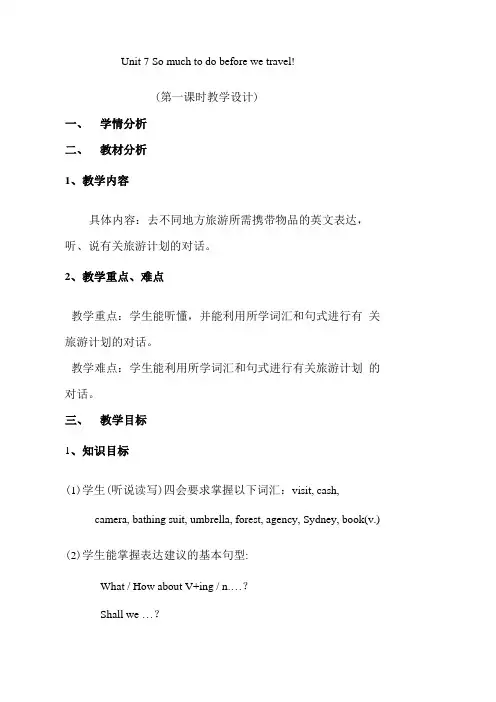
Unit 7 So much to do before we travel!(第一课时教学设计)一、学情分析二、教材分析1、教学内容具体内容:去不同地方旅游所需携带物品的英文表达,听、说有关旅游计划的对话。
2、教学重点、难点教学重点:学生能听懂,并能利用所学词汇和句式进行有关旅游计划的对话。
教学难点:学生能利用所学词汇和句式进行有关旅游计划的对话。
三、教学目标1、知识目标(1)学生(听说读写)四会要求掌握以下词汇:visit, cash,camera, bathing suit, umbrella, forest, agency, Sydney, book(v.)(2)学生能掌握表达建议的基本句型:What / How about V+ing / n.…?Shall we …?Where shall we...?What do we need to take with us?Let’s …That’ a great / wonderful idea.I really like …Sure.That’s cool.四、教学步骤Step One Lead in1.Free talk:2.Show the pictures of Activity 1 one by one, and ask:3.Show a picture of a foreign country and ask:Step Two Listening1.Read the question to the class: “What are Cindy and Annie talking about?”Ss listen and answer. (Activity 3)2.Make sure Ss understand the meanings of the words and phrasesfirst, and then let Ss listen and tick. Check the answers. (Activity 4)Step Three Speaking 1. Ask Ss to read aloud after the tape and underline the wordsand sentences for giving suggestions. (Activity 6)Step Four SummaryAsk Ss to review the words and phrases they have learned in class, and then summarize the sentence structures of giving suggestions. Read them together.Step Five Homework1.Ask Ss to recite the dialogue of listening after class.2.Ask Ss to copy the new words and phrases of this part.3.Ask Ss to get some information about Sydney.板书设计Unit 7 So much to do before we travel!What / How about V+ing /Shall we …Where shall we...What do we need to take with us?Let’s …That' a great / wonderful idea.I really like ...Sure.That's cool.Unit 7 So much to do before we travel!(第二课时教学设计)一、教材分析1、教学内容具体内容:一篇有关在澳大利亚悉尼的旅游介绍,训练学生从中获取细节信息的能力。
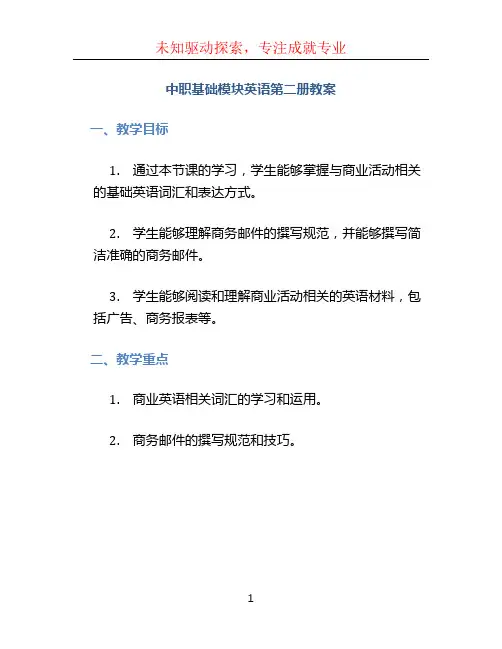
中职基础模块英语第二册教案一、教学目标1.通过本节课的学习,学生能够掌握与商业活动相关的基础英语词汇和表达方式。
2.学生能够理解商务邮件的撰写规范,并能够撰写简洁准确的商务邮件。
3.学生能够阅读和理解商业活动相关的英语材料,包括广告、商务报表等。
二、教学重点1.商业英语相关词汇的学习和运用。
2.商务邮件的撰写规范和技巧。
三、教学内容1. 商业英语词汇学习1.1 商务活动相关的词汇•商务会议:business meeting•商务洽谈:business negotiation•商务合作:business cooperation •采购订单:purchase order•销售合同:sales contract•付款方式:payment method•交付日期:delivery date•货物数量:quantity of goods•价格条款:price terms1.2 商务邮件相关的词汇•主题:subject•收件人:recipient•抄送:cc•附件:attachment•邮件正文:email body•邮件格式:email format•亲切的问候:greeting2. 商务邮件撰写技巧商务邮件是商业活动中常用的沟通工具,良好的商务邮件撰写技巧能够提高商业工作效率和专业形象。
2.1 邮件主题和标题•主题要简洁明了,能够准确表达邮件内容。
•标题要具有吸引力,能够激发对方的兴趣。
2.2 邮件内容结构•首先要介绍自己的身份和目的,有针对性地表达自己的请求或建议。
•其次要提供相关的信息和材料,方便对方了解和处理。
•最后要表达感谢和期待进一步合作的意愿。
2.3 语言风格和表达方式•用简洁明了的语言表达,避免使用过于复杂的词汇和句子结构。
•使用礼貌的表达方式,尊重对方的权威和时间。
•避免语法和拼写错误,保持邮件的专业形象。
3. 商业活动材料阅读与理解商业活动材料包括广告、商务报表等,学生需要掌握阅读和理解这些材料的技巧。
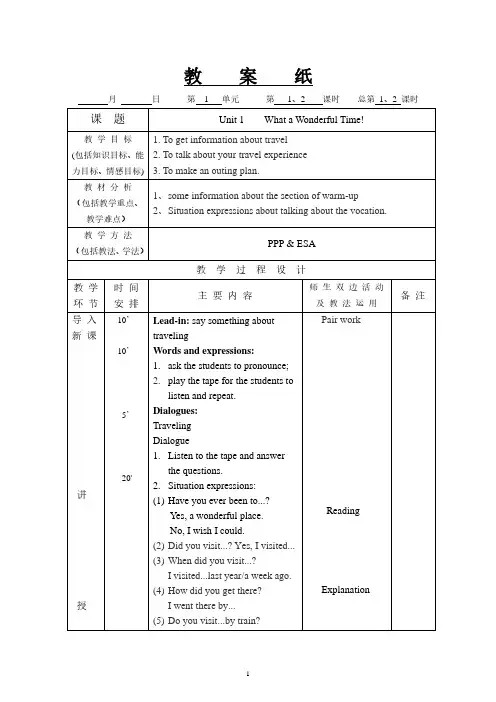
月日第 1 单元第1、2 课时总第1、2 课时课题Unit 1 What a Wonderful Time!教学目标(包括知识目标、能力目标、情感目标)1. To get information about travel2. To talk about your travel experience3. To make an outing plan.教材分析(包括教学重点、教学难点)1、some information about the section of warm-up2、Situation expressions about talking about the vocation.教学方法(包括教法、学法)PPP & ESA教学过程设计教学环节时间安排主要内容师生双边活动及教法运用备注导入新课讲授10’10’5’20'Lead-in: say something abouttravelingWords and expressions:1.ask the students to pronounce;2.play the tape for the students tolisten and repeat.Dialogues:TravelingDialogue1.Listen to the tape and answerthe questions.2.Situation expressions:(1)Have you ever been to...?Yes, a wonderful place.No, I wish I could.(2)Did you visit...? Yes, I visited...(3)When did you visit...?I st year/a week ago.(4)How did you get there?I went there by...(5)Do you visit...by train?Pair workReadingExplanation环节安排主要内容及教法运用备注新课归纳总结布置作业15’5’5’10’5’5’No, I visited the place on foot..(6) How do you like it?exciting...nguage points:(1)a bit(2)no matter(3)go wrong(4)admission ticket4.Practice: finish the chartfinish the dialogue5.Practice the dialogues in pairs.6.Make dialogues about travelingAct out the dialogues in pairs.Sum up:1.Situation expressions;nguage pointsAssignment:1.Read the new words anddialogues;2.Make a dialogue abouttraveling.HomeworkExplanationPracticeWritingOral考勤见教学日志教学体会(教学环节一般包括复习旧课、导入新课、讲授新课、学生操作、教师点评、归纳总结、布置作业等)月日第 1 单元第3、4 课时总第3、4 课时课题Unit 1 what a wonderful time!教学目标(包括知识目标、能力目标、情感目标)1、To learn the passage.2、To understand the passage.教材分析(包括教学重点、教学难点)1、Words and expressions;2、Situation expressions.教学方法(包括教法、学法)PPP & ESA教学过程设计教学环节时间安排主要内容师生双边活动及教法运用备注复习讲授15’10’5’15’5’Review:1. Read and identify new words;2. Act out the dialogues that theymade.Words and expressions:1. Ask the students to pronounce;2. Play the tape for the students tolisten and repeat.Passage:1. Pre-reading questions;2. Listen to the tape and answer thequestions;3. Situation questions:(1) We didn't prepare well for thetrip.(2)We left our flight ticket at home.(3) We were lucky that the fire atthe hotel was put out soon.(4)The bad experience didn't ruinour holiday after all.Pair workOralReadingExplanation环节安排主要内容及教法运用备注新课归纳总结布置作业20’10’5’5’4. Language points:(1)prepare for(2)no matter(3)go wrong(4)arrive at(5)fall asleep(6)put out(7)in time(8)be determined to(9)at the hotel(10)in time5. Read the passage and askquestions.Sum up:1. Situation expressions;2. Words and structures.Assignment:.Read the new words and passageHomeworkExplanationPracticeWritingOral考勤见教学日志教学体会(教学环节一般包括复习旧课、导入新课、讲授新课、学生操作、教师点评、归纳总结、布置作业等月日第 1 单元第5、6 课时总第5、6 课时课题Unit 1 what a wonderful time!教学目标(包括知识目标、能力目标、情感目标)1、To learn some phonetics2、To learn the grammar "Exclamations"教材分析(包括教学重点、教学难点)1、some phonetics2、some use of "Exclamations"教学方法(包括教法、学法)Combined教学过程设计教学环节时间安排主要内容师生双边活动及教法运用备注复习讲授10’10’15’Review:1. Read and identify new words;2. Read the passage;3. have a dictation.Phonetics:1、Listen and read the phoneticsand the words.2、Put some words in the properbasket according to thepronunciation of the endings.Grammar: ExclamationWe use exclamations to express oursurprise, anger, or other strongemotions. Exclamations are oftenconstructed with how/what or withso/such. For example:How cold it is!You are so sweet!Pair worklisteningExplanation。
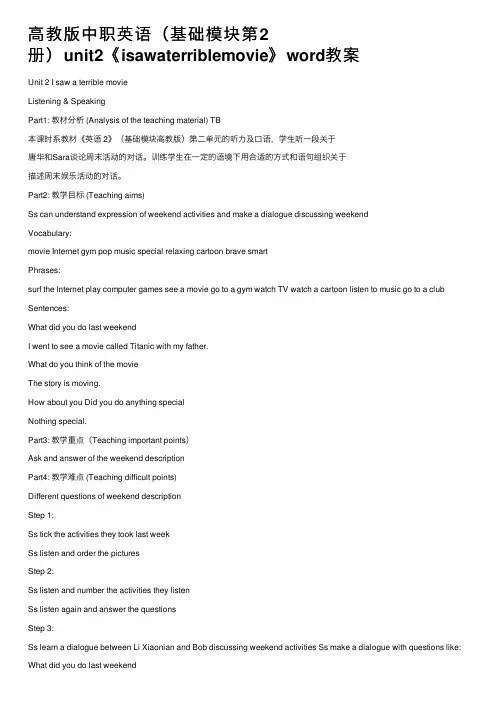
⾼教版中职英语(基础模块第2册)unit2《isawaterriblemovie》word教案Unit 2 I saw a terrible movieListening & SpeakingPart1: 教材分析 (Analysis of the teaching material) TB本课时系教材《英语 2》(基础模块⾼教版)第⼆单元的听⼒及⼝语,学⽣听⼀段关于唐华和Sara谈论周末活动的对话。
训练学⽣在⼀定的语境下⽤合适的⽅式和语句组织关于描述周末娱乐活动的对话。
Part2: 教学⽬标 (Teaching aims)Ss can understand expression of weekend activities and make a dialogue discussing weekendVocabulary:movie Internet gym pop music special relaxing cartoon brave smartPhrases:surf the Internet play computer games see a movie go to a gym watch TV watch a cartoon listen to music go to a club Sentences:What did you do last weekendI went to see a movie called Titanic with my father.What do you think of the movieThe story is moving.How about you Did you do anything specialNothing special.Part3: 教学重点(Teaching important points)Ask and answer of the weekend descriptionPart4: 教学难点 (Teaching difficult points)Different questions of weekend descriptionStep 1:Ss tick the activities they took last weekSs listen and order the picturesStep 2:Ss listen and number the activities they listenSs listen again and answer the questionsStep 3:Ss learn a dialogue between Li Xiaonian and Bob discussing weekend activities Ss make a dialogue with questions like: What did you do last weekendHow about you Did you do anything specialHomework:Review the expression of weekend descriptionPractice the dialogue of weekend descriptionFeedback:Ss can’t answer questions well.Reading &Writing (Unit Task)Part1: 教材分析 (Analysis of the teaching material) TB本课时系教材《英语 2》(基础模块⾼教版)第⼆单元的阅读,阅读关于三个⼈的访谈节⽬的演讲。
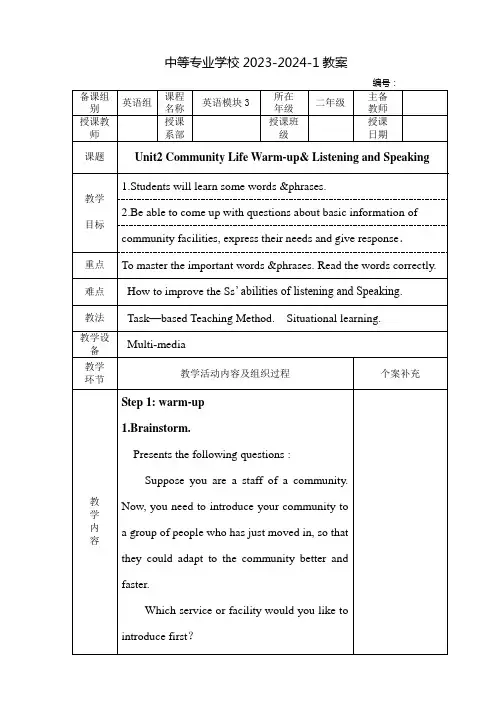
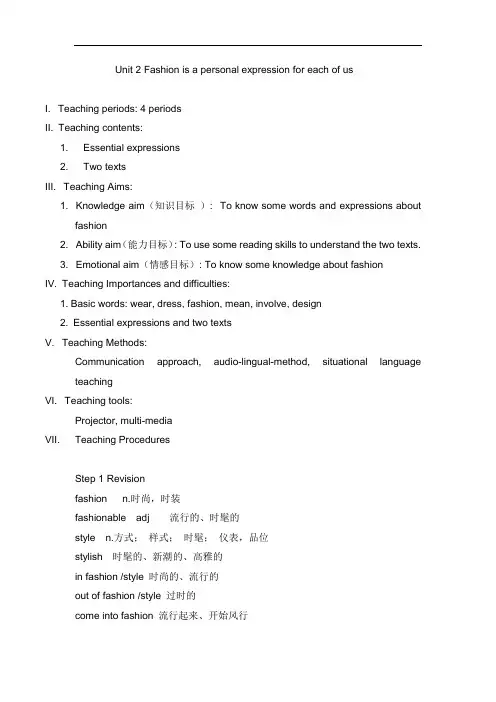
Unit 2 Fashion is a personal expression for each of usI.Teaching periods: 4 periodsII.Teaching contents:1.Essential expressions2.Two textsIII.Teaching Aims:1.Knowledge aim(知识目标):To know some words and expressions aboutfashion2.Ability aim(能力目标): To use some reading skills to understand the two texts.3.Emotional aim(情感目标): To know some knowledge about fashionIV.Teaching Importances and difficulties:1.Basic words: wear, dress, fashion, mean, involve, design2.Essential expressions and two textsV.Teaching Methods:Communication approach, audio-lingual-method, situational language teachingVI.Teaching tools:Projector, multi-mediaVII. Teaching ProceduresStep 1 Revisionfashion n.时尚,时装fashionable adj 流行的、时髦的style n.方式;样式;时髦;仪表,品位stylish 时髦的、新潮的、高雅的in fashion /style 时尚的、流行的out of fashion /style 过时的come into fashion 流行起来、开始风行follow the fashion 赶时髦the latest fashions 最新式样Step 2Words and phrasesin fashion=in style时尚的/流行的latest最新的/最近的hairstyle 发型pearl necklace 珍珠项链fashionable 时尚的fashion show 时尚展/时装表演haircut 理发hairset 发型hair coloring 头发上色hair –do 发式/发型stylish 有风度的/有气派的/有格调的up to now 到现在为止at present 目前,现在a pair of jeans 一条牛仔裤global 全球的elegant 优雅的fit 适合Step 3 Essential Expressionsa1. 现在流行什么/最新的式样是什么?2.请让我看看最新的发型图片/珍珠项链,好吗?3. 你喜欢什么样的发型?4. 这条裙子是今年的流行款吗?5.你认为我穿这条裙子看起来仍然很时尚吗?6. 你觉得这个时尚展怎么样?b1.我想要那件流行的夹克。
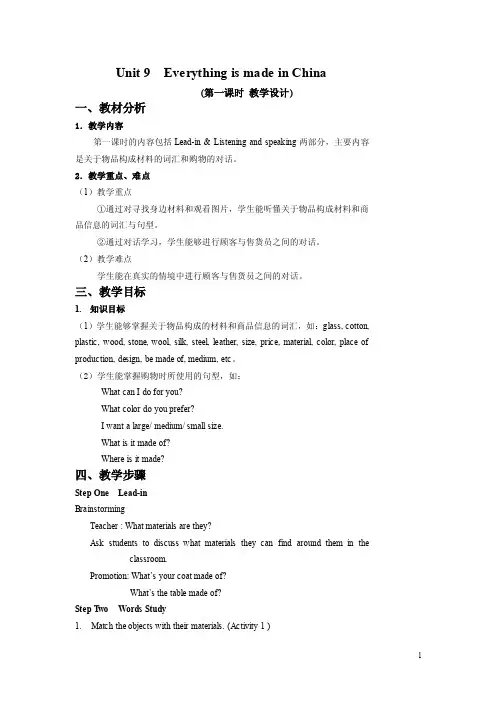
Unit 9 Everything is made in China(第一课时教学设计)一、教材分析1.教学内容第一课时的内容包括Lead-in & Listening and speaking两部分,主要内容是关于物品构成材料的词汇和购物的对话。
2.教学重点、难点(1)教学重点①通过对寻找身边材料和观看图片,学生能听懂关于物品构成材料和商品信息的词汇与句型。
②通过对话学习,学生能够进行顾客与售货员之间的对话。
(2)教学难点学生能在真实的情境中进行顾客与售货员之间的对话。
三、教学目标1.知识目标(1)学生能够掌握关于物品构成的材料和商品信息的词汇,如:glass, cotton, plastic, wood, stone, wool, silk, steel, leather, size, price, material, color, place of production, design, be made of, medium, etc。
(2)学生能掌握购物时所使用的句型,如:What can I do for you?What color do you prefer?I want a large/ medium/ small size.What is it made of?Where is it made?四、教学步骤Step One Lead-inBrainstormingTeacher : What materials are they?Ask students to discuss what materials they can find around them in the classroom.Promotion: What’s your coat made of?What’s the table made of?Step T wo Words Study1. Match the objects with their materials. (Activity 1 )Teacher : Show the words and related pictures of the objects on the screen.Students: Match the objects with their materials.Step Three Listening1. Pre-listeningTeacher: Ask several students about their clothes. The dialogue are as follows:T: What color is your coat?S: It’s ...T: What’s it made of?S: It’s made of ....T: What size is it?S: It’s size L.2. While-listening(1)Listen and answer the questions. (Activity3)(2)Listen again and tick the things they are talking about. (Activity 4)3. Post-listening ( class work and pair work )Step Four Speaking1. Read aloud after the tape and pay attention to the underlined sentences. (Activity 6)Ask students to read the underlined sentences and memorize.What is it made of?It’s made of silk.Where is it made ?I t’s made in China.2. Role play the dialogue between a customer and a shop assistant with the information given. (Activity 7)(1)Teacher makes short dialogues with several students first.Step Five DiscussionTalk about the things you bought recently in pairs.Sample: A: I bought a new scarf last weekend.B: Where is it made?Step Six Homework1. Remember and search more materials about the objects around you.2. Make up a dialogue of asking and giving information about goods.五、板书设计Unit 9 Everything is made in China(第二课时教学设计)一、教材分析1.教学内容本单元阅读活动的目的是训练学生理解描述某人一天购物经历的短文,让学生能在一般的生活、工作语境中使用正确的叙事方式,并能完成相关语言(笔头)输出任务,同时读写活动也为学生完成单元任务作相关的语言准备。
中职英语(高教社2021)基础模块2Unit 2 Health and Fitness教案教学设计(一)第一、第二课时Listening and Speaking一、教材分析本课教学内容选自高等教育出版社出版的“十四五”职业教育国家规划教材,《英语2 基础模块》中Unit 2听说部分,要求学生能围绕就诊情况进行交流,就健康问题给出相关建议并根据实际情况为健康咨询者做出合适的对策。
二、学情分析本课授课对象为中职学校一年级新生。
经过九年的义务教育,他们有一定的英语基础知识储备,但两极分化严重,一部分学生学习兴趣浓厚,能用英语较为流畅地交流;另一部分学生学习兴趣不高,有畏难情绪,不愿意开口。
因此教师对教学活动应进行合理的设计,由易到难,由简到繁,由机械模仿到替换练习,再到语言实践,逐步铺设台阶,把学生可能遇到的困难挫折降到最低。
经过前期的英语学习,学生能够说出headache、fever、toothache、stomachache 等表达健康状况的常见词语,对于询问健康状况及给出合理建议的句型有一定的了解,但仍需要进一步学习。
三、教学目标1. 学生能够听懂有关健康问题和医院就诊的对话,并获取关键信息;2. 学生能够运用句型结合不同的生活方式交流保持健康的看法,提高关注健康的意识;3. 学生能结合关键信息给出合适的咨询建议和就诊意见,培养关心他人的品质。
四、教学重点、难点分析教学重点:能根据不同的健康问题情况进行交流,并能给出合适的建议。
教学难点:能熟练运用咨询健康问题及给出就诊意见的句型。
五、教学过程Step 1 Warming Up*1. Act & Guess.(1)激活词汇储备:学生用动作表示身体不适,其他同学猜测并说出相关的英文词语,教师可适当提供图片作为提示以激活学生思维。
(2)处理教材活动1。
尝试用动作表示allergy和under pressure并请学生说出中文。
2. Think and describe.处理教材活动2。
点击职业英语教案教研室:教师姓名:课程名称英语授课班级apartment. 授课学时 6授课内容Unit 2 This isn’t your教学方法交际法,小组讨论法,任务型学习法,翻转课堂教学法教学目标 1 知识目标:掌握用来谈论家庭及所属的基本词汇句型2 能力目标:能用英语谈论家庭、能力;能读懂通知;掌握通知写作技巧3 情感目标:了解东西文化差异教学重点角色扮演;人称代词和指示代词的意义和用法谈论家庭的词汇和句型教学难点掌握通知写作技巧掌握谈论家庭及所属的基本词汇句型教学手段多媒体、图片、黑板教学过程 1.学习目标2.热身活动}(1学时)3.主题对话4.语法栏目(1学时)5.词汇练习(1学时)6.听力阅读(1学时)7.阅读(1学时)8-11实用阅读及写作(1学时)教学内容Goals:Teacher: In this unit students are going to learn to talk about things (their possessions) and aboutpeople (their family)Identifying things and peopleTalking about possessionTalking about familyWarm UpDiscuss:Do you know how to identify things and groups of people?How do you express your things and others’?List the members of a big family.A. PAIR WORK Match the hats with the correct people. Point to the hats and the people.Identify the hats.Responses:John = cowboy hat;Julia = chef’s hat;Bruce = baseball cap;Steve = construction hat;Liz = policeman’s hatB. PAIR WORK. Listen. Match the people with their objects. Write the number of theperson next to each object.Have students look at the illustrations. Model the pronunciation of each object for them.Answer key: a. 3-Bruce b. 2-Julia c. 4-Steve d. 5-Liz e. 1-JohnConversationWho are you?A. Listen and practice.Have students look at the photos and ask “Who is he/she?”“Where are they?”“Wha carrying?”Tell students to listen to the conversation and follow the text in their books to find out whereBrad and Jason are.B. Did you notice the language? Can you fill in the blanks?Put the subject pronouns on the board and have students look back at the conversation toelicit as many corresponding possessive forms as possible. Then provide the rest.1. Stacey is in ________ apartment.2. Jason and Brad are _______new neighbors.3. Jason introduces ________ brother to Stacey.GrammarIdentifying things and groups of peopleTell students they are going to use demonstratives(this/that/these/those) to talk about thingsor objects and write them on the board.Tell students that we use this to talk about objects near to the speaker.We use tha t when the object is further from the location of the speaker.Repeat questioning with examples of plural objects using these and those.指示代词指示代词是具有指示概念的代词this 这;that 那;these 这些;those 那些;指示代词的用法this、that、these、those 在句子中作主语、宾语、表语或定语。
中职高教版英语2基础模块1--4单元教案单元1 教案课题:Unit 1: Greetings目标- 熟悉问候语并能正确运用;- 研究日常用语,能流利地进行简单的交流;- 了解和尊重各种文化背景。
教学内容1. Greetings and introductions2. Expressing likes and dislikes3. Cultural awareness: Greetings in different cultures教学步骤1. 导入:- 播放一段问候语的视频,引起学生的兴趣;- 小组讨论:中华民族的问候方式。
2. 研究重点词汇和句型:- 向学生展示关于问候语和自我介绍的词汇和句型;- 引导学生模仿表达。
3. 游戏活动:- 分组进行问候的角色扮演,学生使用所学的问候语进行对话;- 教师引导学生进行互相介绍的活动。
4. 文化背景研究:- 向学生介绍不同文化背景下的问候方式;- 学生展示自己研究的文化背景相关信息。
5. 小结和练:- 教师复所学内容,学生回答相关问题;- 学生进行问候语练。
6. 课堂作业:- 要求学生以书面形式写一篇关于自己所研究的文化背景问候方式的小短文。
教学资源- 视频资源:问候语视频- PPT:关于问候语和自我介绍的词汇和句型展示单元2 教案课题:Unit 2: Daily Routines目标- 研究并能正确运用日常活动的词汇;- 能以简单的句子描述日常活动的顺序;- 发展学生的时间管理能力。
教学内容1. Daily routine vocabulary2. Sequencing daily activities3. Time management skills教学步骤1. 导入:- 展示几幅关于日常活动的图片,引发学生讨论;- 学生自由发言,描述自己的日常活动。
2. 研究重点词汇和句型:- 提供日常活动的词汇表,学生进行研究;- 学生利用所学词汇描述自己的日常活动顺序。
教案纸月日第 1 单元第1、2 课时总第1、2 课时(教学环节一般包括复习旧课、导入新课、讲授新课、学生操作、教师点评、归纳总结、布置作业等)教案纸月日第 1 单元第3、4 课时总第3、4 课时(教学环节一般包括复习旧课、导入新课、讲授新课、学生操作、教师点评、归纳总结、布置作业等教案纸月日第 1 单元第5、6 课时总第5、6 课时(教学环节一般包括复习旧课、导入新课、讲授新课、学生操作、教师点评、归纳总结、布置作业等)教案纸月日第 2 单元第1、2 课时总第7、8 课时(教学环节一般包括复习旧课、导入新课、讲授新课、学生操作、教师点评、归纳总结、布置作业等)教案纸月日第 2 单元第3、4 课时总第9、10 课时(教学环节一般包括复习旧课、导入新课、讲授新课、学生操作、教师点评、归纳总结、布置作业等教案纸月日第 2 单元第5、6 课时总第11、12 课时(教学环节一般包括复习旧课、导入新课、讲授新课、学生操作、教师点评、归纳总结、布置作业等)教案纸月日第 3 单元第1、2 课时总第13、14 课时(教学环节一般包括复习旧课、导入新课、讲授新课、学生操作、教师点评、归纳总结、布置作业等)教案纸月日第 3 单元第3、4 课时总第15、16 课时(教学环节一般包括复习旧课、导入新课、讲授新课、学生操作、教师点评、归纳总结、布置作业等教案纸月日第 3 单元第5、6 课时总第17、18 课时(教学环节一般包括复习旧课、导入新课、讲授新课、学生操作、教师点评、归纳总结、布置作业等)教案纸月日第 4 单元第1、2 课时总第19、20 课时(教学环节一般包括复习旧课、导入新课、讲授新课、学生操作、教师点评、归纳总结、布置作业等)教案纸月日第 4 单元第3、4 课时总第21、22 课时(教学环节一般包括复习旧课、导入新课、讲授新课、学生操作、教师点评、归纳总结、布置作业等教案纸月日第 4 单元第5、6 课时总第23、24 课时(教学环节一般包括复习旧课、导入新课、讲授新课、学生操作、教师点评、归纳总结、布置作业等)教案纸月日第 5 单元第1、2 课时总第25、26 课时(教学环节一般包括复习旧课、导入新课、讲授新课、学生操作、教师点评、归纳总结、布置作业等)教案纸月日第 5 单元第3、4 课时总第27、28 课时(教学环节一般包括复习旧课、导入新课、讲授新课、学生操作、教师点评、归纳总结、布置作业等教案纸月日第 5 单元第5、6 课时总第29、30 课时(教学环节一般包括复习旧课、导入新课、讲授新课、学生操作、教师点评、归纳总结、布置作业等)教案纸月日第 6 单元第1、2 课时总第31、32 课时(教学环节一般包括复习旧课、导入新课、讲授新课、学生操作、教师点评、归纳总结、布置作业等)教案纸月日第 6 单元第3、4 课时总第33、34 课时(教学环节一般包括复习旧课、导入新课、讲授新课、学生操作、教师点评、归纳总结、布置作业等教案纸月日第 6 单元第5、6 课时总第35、36 课时(教学环节一般包括复习旧课、导入新课、讲授新课、学生操作、教师点评、归纳总结、布置作业等)教案纸月日第7 单元第1、2 课时总第37、38 课时(教学环节一般包括复习旧课、导入新课、讲授新课、学生操作、教师点评、归纳总结、布置作业等)教案纸月日第7 单元第3、4 课时总第39、40 课时(教学环节一般包括复习旧课、导入新课、讲授新课、学生操作、教师点评、归纳总结、布置作业等教案纸月日第7 单元第5、6 课时总第41、42 课时(教学环节一般包括复习旧课、导入新课、讲授新课、学生操作、教师点评、归纳总结、布置作业等)教案纸月日第8 单元第1、2 课时总第43、44 课时(教学环节一般包括复习旧课、导入新课、讲授新课、学生操作、教师点评、归纳总结、布置作业等)教案纸月日第8 单元第3、4 课时总第45、46 课时(教学环节一般包括复习旧课、导入新课、讲授新课、学生操作、教师点评、归纳总结、布置作业等教案纸月日第8 单元第5、6 课时总第47、48 课时(教学环节一般包括复习旧课、导入新课、讲授新课、学生操作、教师点评、归纳总结、布置作业等)教案纸月日第9 单元第1、2 课时总第49、50 课时(教学环节一般包括复习旧课、导入新课、讲授新课、学生操作、教师点评、归纳总结、布置作业等)教案纸月日第9 单元第3、4 课时总第51、52 课时。